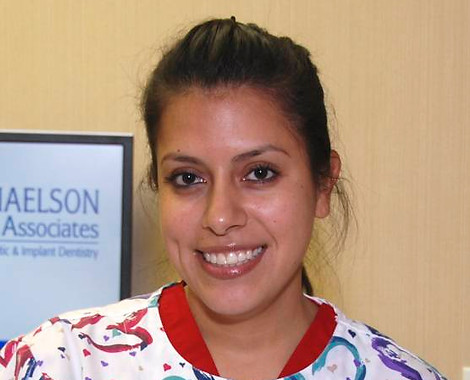- 450 Grand Blvd, Deer Park, NY 11729, USA
- (631) 667-4080
- smile@RaphaelsonDDS.com
Dental Hygiene
Prophylaxis and Routine Care
A dental prophylaxis is a cleaning procedure performed to thoroughly clean the teeth. Prophylaxis is an important dental treatment for halting the progression of periodontal disease and gingivitis.
Prophylaxis is a preventative procedure to help keep the oral cavity stay in good health and prevent the progression of gum disease.
Here are some of the benefits of prophylaxis:
Tartar removal
Even with great homecare techniques, it can be impossible to remove debris, bacteria, and deposits from gum pockets. The experienced eye of a hygienist using specialized dental equipment is needed in order to spot and treat problems such as tartar and plaque buildup.
Aesthetics
Prophylaxis can rid the teeth of unsightly stains.
Fresher breath
Periodontal disease is often signified by persistent bad breath (halitosis). The removal of plaque, calculus, and bacteria noticeably improves breath and alleviates irritation.
Identification of health issues
Many health problems first present themselves to the dentist. Since prophylaxis involves a thorough examination of the entire oral cavity, we will examine you for tooth decay, gum disease, infections, tumors, and other dental problems.
At Raphaelson Dental Associates we recommend that everyone visit the dentist at least once per year. Prophylaxis is recommended twice annually as a preventative measure if you do not have signs of periodontal disease!
Our Digital X-rays are at least 90% less radiation than conventional film X-rays. Our digital X-rays contain sensors that can go into great detail allowing us to offer the best treatment to our patients. It is important that our patients allow us to take necessary X-rays, without them we are not able to properly assess your dental health.
PERIODONTAL TREATMENT
Non Surgical- less invasive and cost effective
Raphaelson Dental Associates offers non surgical treatment for periodontal disease called scaling and root planing. This procedure is often called a deep cleaning – is considered the “gold standard” of treatment for patients with chronic periodontitis, as stated in the Journal of Evidenced-Based Dental Practice.
Healthy gum tissue fits tightly around each tooth, and measuring from the top of the gumline to where it attaches to the tooth should only be 1 to 3 millimeters in depth. But, when bacterial plaque and tartar accumulate around and under the gums, tissues that support your teeth may be affected and periodontal disease can develop causing deeper pockets to form. These bacteria cause serious inflammation and irritation which in turn produce a chronic inflammatory response in the body. As a result, the body begins to systematically destroy gum and bone tissue, making the teeth shift, become unstable, or completely fall out. The pockets between the gums and teeth become deeper and harbor more bacteria which can travel into the bloodstream and infect other parts of the body.
In some studies, researchers have observed that people with Periodontal Disease (when compared to people without ) were more likely to develop heart disease or have difficulty controlling blood sugar. Other studies showed that women with Periodontal Disease were more likely than those with healthy gums to deliver preterm, low birth weight babies. Periodontal Disease has been linked to other conditions include stroke, Alzheimer’s and dementia, erectile dysfunction, pancreatic cancer and much more. In the meantime, it’s a fact that controlling Periodontal Disease can save your teeth – a very good reason to take care of your teeth and gums.
When you have more advanced signs of gum disease (bad breath, heavy tartar buildup and unhealthy pocket depths of 4mm or more), you may recommend scaling and root planing as the first procedure necessary to treat the condition.
Our dental hygienists’ remove the plaque through a deep-cleaning method called scaling and root planing. Scaling means removing the calculus (tartar) from above and below the gum line. Root planing gets rid of rough spots on the tooth root where the germs gather and will help remove bacteria that contribute to the disease.
Scaling and Root Planing, also known as a dental deep cleaning, is very different from a regular cleaning. A regular cleaning focuses on the surfaces of the teeth and between teeth above the gum line. During a regular cleaning, the teeth are also polished. Since this procedure is a deeper cleaning that requires us to below the gingiva, we will administer Novocaine to ensure your comfort. Each cleaning will be done by the quadrants in your mouth depending on the troubled areas.
A dental deep cleaning, or scaling and root planing, is needed in order to remove bacteria, calculus (tartar), and debris that has collected under the gingiva. The presence of calculus under the gingiva creates a safe haven for bacteria to collect, and cannot be removed by brushing, flossing or with a regular cleaning. In addition, we recommend the following medications in conjunction with Scaling and Root planing to help combat this disease:
Localized Delivery of Chemotherapeutic Agents: In deep pockets, you may choose to have an antibiotic gel placed to further kill any remaining bacteria. Studies show that this improves healing and reattachment by as much as 62% when done in conjunction with a deep cleaning. The gel slowly dissolves over a period of 1-3 months. It has no systemic effects.
Periostat: Periostat slows down the progression of gum and bone breakdown around teeth. It is taken orally twice a day. It is a very low dose of Tetracycline.
Chlorhexidine Rinse: This is a liquid medicine that is a strong antimicrobial agent. It is one of the best rinses available that has been shown to kill gum disease causing bacteria and has been safe to use in dentistry for many decades.
In our practice, we find that good daily home care is very important in helping slow down and reverse the progression of Periodontal Disease.
MEET OUR HYGIENISTS

Donna Frole

Nicole Godfrey

Elizabeth Penza

Allison Pike

Kerry Roca

Maria Bilello

